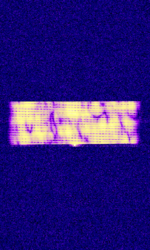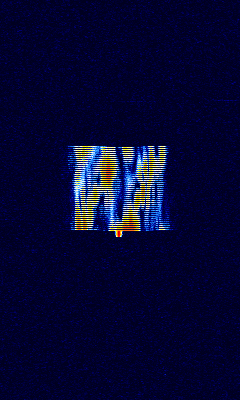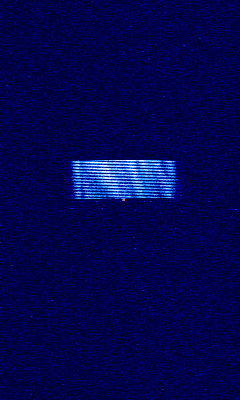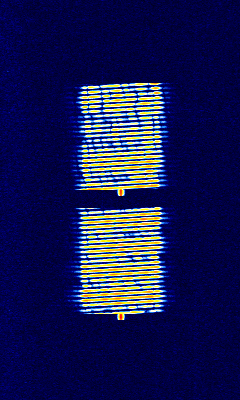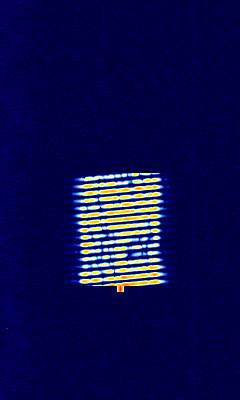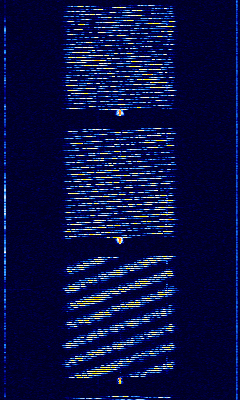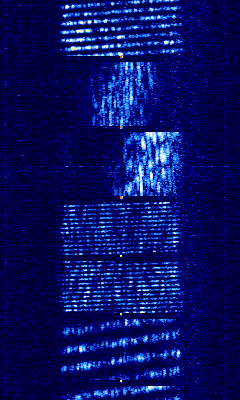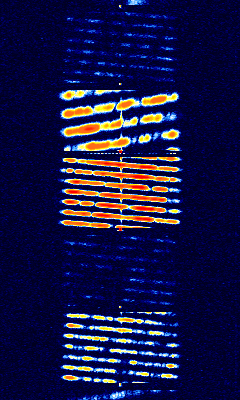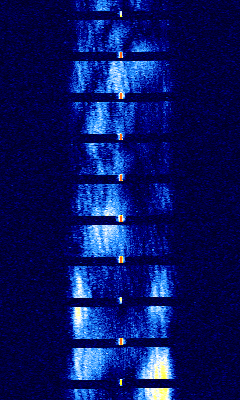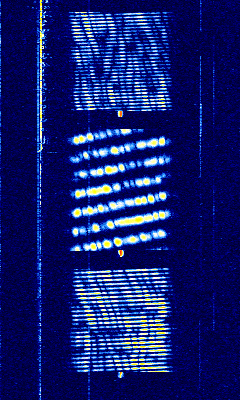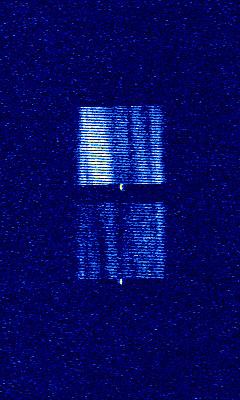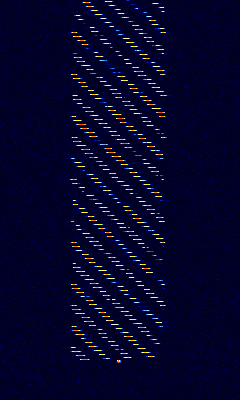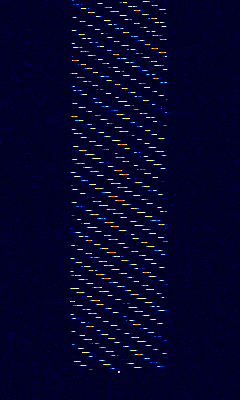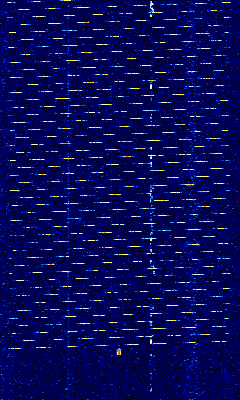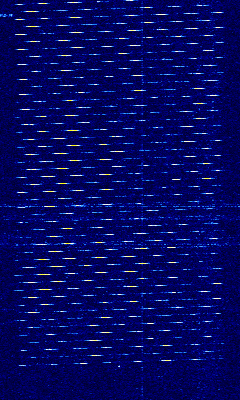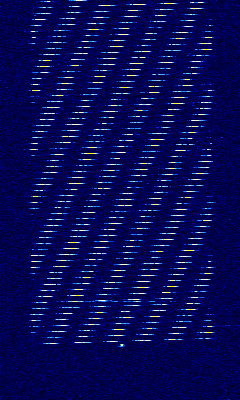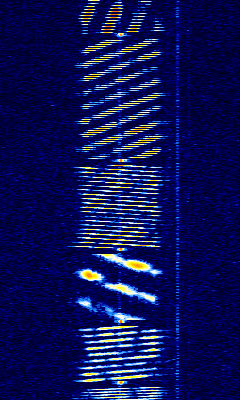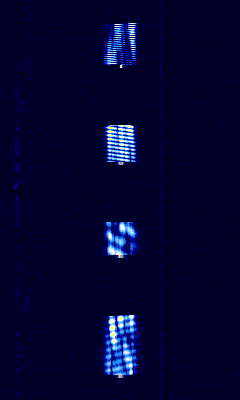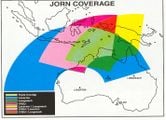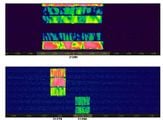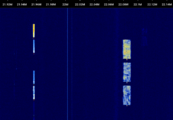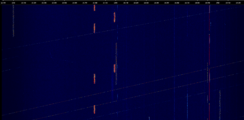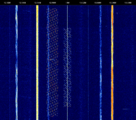Jindalee Operational Radar Network (JORN)
| Radars | |
|---|---|
| Military: 'Ghadir' OTH Radar (Iran) - 29B6 'Kontayner' OTH Radar (Russia) - Chinese 'Foghorn' OTH radar (China) - 'OTH-SW' OTH Radar (China) - Jindalee Operational Radar Network (JORN) (Australia) - PLUTO II OTH Radar (Cyprus/UK Base) - Relocatable Over-the-Horizon Radar (ROTHR) (US) Civil: CODAR (Worldwide) - Canadian Meteor Orbit Radar (CMOR) (Canada) - High Frequency Active Auroral Research Program (HAARP) (Alaska, US) - SIMONe meteor radar (Worldwide) - SKiYMET meteor radar (Worldwide) - SuperDARN (Super Dual Auroral Radar Network) (Worldwide) *VHF |
JORN is an Australian over-the-horizon radar system. It transmits an FMCW signal in bursts, and each burst has an intro tone. Sweep rates can vary over a wide range. The most common bandwidth is 10 kHzKiloHertz (kHz) 10^3 Hz but other bandwidths such as 3 kHzKiloHertz (kHz) 10^3 Hz or 15 kHzKiloHertz (kHz) 10^3 Hz may be used. The sounder modes (see below) use many different bandwidths. Transmission frequency can vary from 5.7 MHzMegaHertz (MHz) 10^6 Hz to 33 MHzMegaHertz (MHz) 10^6 Hz or even lower or higher.
The intro tone can be very short and plain, or it can be slightly longer and have noticeable modulation. It is not known why different intro tones are used. The radar can also transmit without an intro tone, but it's uncommon, see the video example below. The purpose of the intro tone has not been confirmed, but according to a post in the UDXF group, it is used to check impedance matching between the transmitters and the antennas. If impedance matching is not correct, transmission would be aborted.
JORN's OTHOver The Horizon (very long range) network is comprised of three radar sites. One at Alice Springs (1RSU), the first OTHOver The Horizon (very long range) to be built in Australia, and two other ones at Laverton and Longreach.
JORN can be confused with the Relocatable Over-the-Horizon Radar (ROTHR) of USA, but can be usually differentiated by its different bandwidth and different intro tone. The waterfall appearance of HFDL also resembles JORN but the former can be differentiated by its narrow bandwidth and entirely different sound when demodulated.
Samples[edit]
The following samples are USBUpper Side Band Modulation (Radio, referring to reception and modulation mode)Universal Serial Bus (Computer, referring to USB Ports and cables) with narrow and wide bandwidths unless described otherwise. Transmission bandwidth was 10 kHzKiloHertz (kHz) 10^3 Hz in most cases as it is the most common bandwidth used by this radar. Wide USBUpper Side Band Modulation (Radio, referring to reception and modulation mode)Universal Serial Bus (Computer, referring to USB Ports and cables) sample covers the entire transmission, narrow USBUpper Side Band Modulation (Radio, referring to reception and modulation mode)Universal Serial Bus (Computer, referring to USB Ports and cables) sample is about 2.8 kHzKiloHertz (kHz) 10^3 Hz wide.
| Single burst, modulated intro tone | Single burst, short and plain intro tone |
Two bursts, modulated intro tone | Single burst, AMAmplitude Modulation and FMFrequency Modulation samples. Note intro tone modulation in AMAmplitude Modulation. |
|---|---|---|---|
| |
|
|
|
| Repeating bursts, slow sweep rates, modulated intro tone |
Repeating bursts, short and plain intro tone |
Repeating bursts, short intro, varying strength, possible beam steering |
Repeating bursts, faster sweep rate (67 HzHertz (Hz), unit of frequency, defined as one cycle per second (1 Hz).), about 8 kHzKiloHertz (kHz) 10^3 Hz bandwidth |
|---|---|---|---|
| |
|
|
|
| Three bursts with 12 kHzKiloHertz (kHz) 10^3 Hz bandwidth, modulated intro tone |
Two bursts with 8 kHzKiloHertz (kHz) 10^3 Hz bandwidth, modulated intro tone |
|---|---|
| |
|
Sounder mode[edit]
These are samples of a sounder mode that is believed to originate from JORN. The purpose of this mode has not been confirmed but it may be used for ionospheric sounding to check ionospheric conditions so that optimal frequency can be chosen for the main radar transmission.
The sounder mode typically uses slow sweep rates of less than 10 HzHertz (Hz), unit of frequency, defined as one cycle per second (1 Hz). and bandwidth from 3 kHzKiloHertz (kHz) 10^3 Hz up to 50...60 kHzKiloHertz (kHz) 10^3 Hz. Either 64 or 128 sweeps are usually transmitted. Transmissions often happen on or near integer MHzMegaHertz (MHz) 10^6 Hz frequencies, and after one transmission is complete, frequency is typically changed by 1 MHzMegaHertz (MHz) 10^6 Hz downwards or sometimes upwards. Unlike some other OTHOver The Horizon (very long range) radars, this sounder mode often seems to avoid frequencies that are in use. This behavior is seen when the sounder chooses a frequency that is slightly above or below the expected integer MHzMegaHertz (MHz) 10^6 Hz value.
The samples in the following examples are in USBUpper Side Band Modulation (Radio, referring to reception and modulation mode)Universal Serial Bus (Computer, referring to USB Ports and cables) mode, with narrow and wide bandwidths.
| 7 sweeps/sec, 12 kHzKiloHertz (kHz) 10^3 Hz wide, 128 sweeps |
7 sweeps/sec, 11.5 kHzKiloHertz (kHz) 10^3 Hz wide, 128 sweeps, short intro tone |
4 sweeps/sec, 30 kHzKiloHertz (kHz) 10^3 Hz wide, 64 sweeps, modulated intro tone |
4 sweeps/sec, 30 kHzKiloHertz (kHz) 10^3 Hz wide, 64 sweeps, short intro tone |
|---|---|---|---|
| |
|
|
|
| 5 sweeps/sec, 15 kHzKiloHertz (kHz) 10^3 Hz wide, 128 sweeps, modulated intro tone |
|---|
| |
16x64 sounder mode[edit]
The 16x64 sounder is a special mode used by JORN. In this mode, the radar transmits 16 bursts, each with 64 FMCW sweeps, with sweep rate decreasing after each burst. Like the basic sounder mode, this mode also typically hops in 1 MHzMegaHertz (MHz) 10^6 Hz steps downwards. Bandwidth of this mode is usually 3 kHzKiloHertz (kHz) 10^3 Hz.
The purpose of the 16x64 sounder mode is not known but it has been suggested that it's used to check ionospheric conditions. It has also been called "searchlight mode".
A 14-burst variant with pauses between bursts and changes in sweep count has been observed in 2024.
| 16x64 sounder, 3 kHzKiloHertz (kHz) 10^3 Hz BW | "14-sounder" variant, 3 kHzKiloHertz (kHz) 10^3 Hz BW |
|---|---|
Video Examples[edit]
- Over The Horizon Radar 18,020 Khz
- 16x64 sounder on 8998 kHz
- JORN with 10 kHz bandwidth, also shows a glimpse of 3 kHz and differences vs. ROTHR
- JORN demodulated in AM mode
- JORN changing between frequencies
- JORN sounder mode
- Likely JORN sounder mode
- 16x64 sounder
- 16x64 sounder hopping frequencies
- 16x64 sounder without intro tones
Additional Links[edit]
- Wikipedia Jindalee Operational Radar Network
- I-56578 JORN OTH
- Spench.net JORN Network List
- IARUMS Radar Info Sheet
- JORN Fact Sheet
- Lockheed Martin JORN
- Australian Department of Defense Jindalee Operational Radar Network Information
